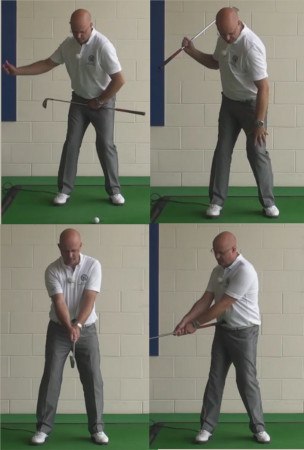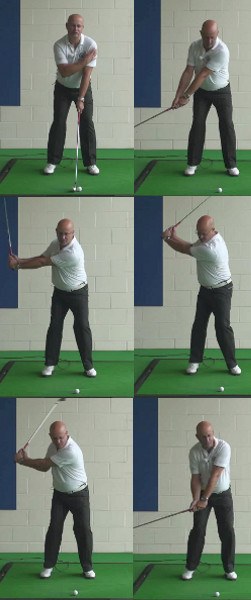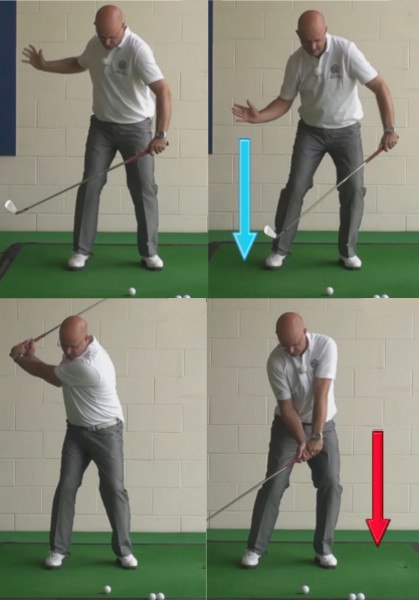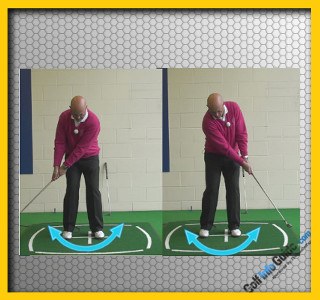Learning to have the correct weight shift in your golf swing will add yards to how far you can strike the golf ball.

However, the shift of weight in your swing should not be forced. It is something that should happen as a product of you moving well during your golf swing. At address, your arms and the golf club are in front of your body and relatively centred with your body. This results in your centre of gravity being centred and as a result your weight is balanced and relatively even between both feet.
As you swing back away from the golf ball, because your arms move to the right of your body, your centre of gravity shifts to the right and therefore your weight moves to the right. At the top of your backswing, you should have 65-70% of your weight on your right side. As you swing back down towards the ball, your arms swing back to in front of your body and then continue to the left of your body, moving your centre of gravity to the left and as a result, your weight shifts to the left, finishing 90-95% on your left foot at the end of your swing. In a basic format, as the golf club moves to the right, your weight moves to the right and as your club moves to the left, your weight moves to the left.
If you are not experiencing this weight shift then work on the following. At address, imagine the target line extended to the right of the golf ball. As you swing the club head away from the ball, move it along the target line for longer. Keep your head static as you do this to prevent you from swaying to the right and just stretch your arms away from your body to keep the club head moving down the target line.
In stretching your arms to the right in this way, you will notice the shift in your weight to the right.
If you are not transferring your weight correctly on your downswing, try the following exercise. Your downswing should start with you rotating your knees and hips towards the target. This movement then flows into your torso and upper body as your weight shifts left. To encourage this, stand with your backside against a wall and take up your address position. As you swing back, the right side of your backside will be in contact with the wall and the left side will move off it. To transfer your weight correctly on your downswing, replace the left side of your backside on to the wall and then continue to rotate your pelvis so that the left outer seam of your trouser leg touches the wall as you complete your swing.
These two drills will get you shifting your weight correctly during your golf swing and will allow you to hit the ball more consistently and further.

What is the Correct Swing Weight Shift Takeaway and Downswing?
The 'weight shift' is one of the most interesting, and misunderstood, topics in the entire game of golf. If you have played this game for any length of time, you have no doubt spent at least a little practice effort trying to figure out how to control your center of gravity. Where should your weight move during the swing? Do you need to shift from side to side quickly as the club swings through? There is a lot of confusion on this topic in amateur golf circles, and that confusion usually leads to poor results. Clear up your thinking on this topic and you can take your game in the right direction.
It is important to use your body properly if you want to create a golf swing which is both powerful and reliable. While your hands are the only part of your body which will actually be touching the club, your entire body – from your head to your toes – will have influence on the outcome of each shot. You don't want to be fighting against yourself by having certain parts of your body out of place during the swinging action. Get everything working together from address on through to the finish and the ball will suddenly find its way to the target far more frequently.
There are two distinct phases to every golf swing – the takeaway (or backswing) and the downswing. You need to understand how your weight should be working during each of these phases in order to bring the entire swing together as a complete package. As you might imagine, your weight does not work in the same way during the backswing as it does the downswing, so each phase is going to need its own time and attention on the range. There are a lot of moving parts in a golf swing, and no one ever accused this game of being easy. If you want to make progress toward a lower handicap in the coming months and years, paying attention to the small details of your swing is a great place to start.
Before we get into the discussion on proper weight shift, it needs to be mentioned that not everything you do with your swing should be based on adding distance. Sure, it is great to have plenty of distance at your disposal, but you need to be able to control your golf ball as well. Without control, your power will be useless and you will struggle to get around the course with a decent score. When it comes to weight shift, you can add some power to your game by using your weight the right way – but this topic is more about control than anything else. With your body in the right place throughout the swing, you can apply the club to the ball in the same manner time after time. That consistency is going to mean more control over your shots, and it is going to mean lower scores in the long run.
All of the content below is based on a right-handed golfer. If you happen to play left-handed, please take a moment to reverse the directions as necessary.

Ruling Out the Slide
Later in this article, we will get into the details of how you should use your weight during both the backswing and the downswing. However, before we even go that far, we need to tackle an important topic right up front – the slide. Countless amateur golfers believe they need to slide – or shift – from side to side as they swing the club. This is wrong, plain and simple. There should be no slide in your golf swing, in either direction. If you are sliding to the right in the backswing, to the left in the downswing, or both, you are making a serious mistake. There is almost no way to create power with this kind of swing, and you will be likely to produce a slice as well.
Golfers who use a lateral slide in their swing think that this technique makes sense, since the club needs to move through the ball from right to left anyway. As long as the club is moving in that direction, shouldn't your body be moving that way as well? Simply put, no, it should not. The club is actually moving parallel to the target line for only a very brief period of time. During the rest of the swing, it is moving in a rotational manner. Therefore, you want to use your body rotationally as well, rather than moving it from side to side. With a rotational swing, which we will get into later in this article, you can unlock power and control you never knew you had.
To make sure you aren't tempted to adopt, or stick with, a swing which uses a significant lateral slide, the following list highlights some of the many problems with this kind of technique.
- Difficult to generate speed. When you rotate your body through the swing, you can produce a tremendous amount of speed by the time the club head reaches the ball. That simply won't be possible with a sliding action. You can only slide so far, as you can't slide as fast as you can turn. You will be left with a swing that has minimal power, meaning you will always be struggling to hit the ball far enough out on the course. Every golfer loves to hit the ball far into the distance, and you are only going to be able to do that when you use rotation to your advantage.
- Hard to hold your balance. One of the worst things about the lateral slide is the damage that it can do to your balance. You need to be nicely balanced as you swing the golf club, yet that goal is going to be out of reach if you are moving dramatically from side to side. Instead, your weight should remain somewhere in the middle of your stance, with the rotation of your body doing the work of moving the club. When you rotate rather than slide, it will be remarkably easy to remain balanced over the ball.
- Likely to hit the ball fat. Players who slide through their downswing often struggle with the mistake of hitting the ball fat. By hitting behind the ball, you will leave your shots short of the target – and you might not be able to clear any hazards which may be between you and the hole. Clean contact is one of those things that you can't do without in golf, so get rid of your slide to make sure you can find the ball solidly time after time.
- A high, floating ball flight. When playing iron shots, you need to hit down through the ball at impact in order to produce a solid, penetrating flight. Unfortunately, that will be tough to do if you slide through the shot. Instead, you will wind up scooping the ball at impact, tossing it high up into the air with minimal forward momentum. These kinds of shots usually float off line before they come down well short of their intended target. Eliminating your slide should promote a more powerful ball flight, one which will hold its line and give you a better chance of playing well in a variety of conditions.
By this point, it should be perfectly clear that you do not want to be sliding from side to side in your swing. Instead, you need to rotate aggressively in order to move the club into position. Throughout the rest of the article, we will outline how you can use the movement of your body to produce an excellent ball flight swing after swing.

Managing Your Weight in the Backswing
As mentioned earlier, we are going to divide up the instruction in this article into two distinct halves – the backswing, and the downswing. First, we will deal with the backswing. While it is easy to overlook the backswing as you are focused on making great contact, getting things right on the way back will help you to deliver the club properly at the bottom of the swing. Think of your backswing as the foundation of your house – without a solid foundation, the house is not going to stand.
There are a few key points to keep in mind with regard to your 'weight shift' in the backswing. Those points are listed below.
- Keep your center of gravity in place. At address, your center of gravity should be precisely halfway between your two feet – and it should stay that way throughout the backswing. This is a point that surprises many beginning golfers. You don't actually want your weight to move in any significant way as the backswing develops. Rather, you want your balance to remain in place, as your body simply turns in place. You are going to make a big shoulder turn in the backswing, but your weight shouldn't be moving laterally at all – you will be just as balanced at the top of the swing as you were at address. If anyone has told you that you need to 'get onto your right side' during the backswing, you can feel free to ignore them. That isn't how the golf swing works. Stay balanced, keep your weight in the middle of your stance, and focus on making the best shoulder turn possible.
- Stay down. In addition to keeping your weight evenly distributed between your two feet, you also need to make sure you are staying down nicely. This means maintaining the knee flex you had at address all the way through the backswing. If you get too high by standing up out of the shot, it will be difficult to rotate correctly in the downswing. So, not only do you have to think about controlling your weight laterally, but vertically as well. You should feel like you are sitting into your stance at address, and that feeling should not change as the backswing moves along. If you can stay down in your stance all the way to the top, you will be perfectly poised for a powerful strike down into the ball.
- Don't turn too far. You probably know that making a big shoulder turn is great news for the amount of swing speed you can generate in the downswing. However, you can go too far in this regard. If you force yourself to swing back as far as possible, you might actually pull yourself off balance. As your shoulder turn continues, it could drag your weight to the outside of your right foot, at which point you would have very little chance to recover. It is important that you resist the temptation to turn so far back that you begin to lose control. Make a big turn, but stop and change directions while you are still comfortably in control of the action.
There isn't much to be done actively in the backswing with regard to your weight. Basically, at this point, you are trying to not make any mistakes. If you can keep your weight centered while you turn, you will be ready for an aggressive downswing. Spend time working on your backswing before you get into the details of making a great downswing move through the ball and into the finish.

Unleashing the Downswing
Golf is not generally considered to be an aggressive game. After all, it is played by mostly mild-mannered people wearing nice clothes, and you aren't even allowed to talk while other people are hitting their shots. Golf is a long way from football, or any other sport where aggression and speed and important characteristics.
However, when you transition from backswing to downswing, you do need to kick your mind into an aggressive mode. It is important to be aggressive during this part of the swing, as you only have a limited amount of time to accelerate the club from the top of the swing down to the point of impact. That is a fixed distance, so you need to do everything possible to bring the club up to top speed in time. If you are lazy at any point in the downswing, you will have wasted an opportunity that you aren't getting back.
The best way to start the downswing is to rapidly rotate your hips through the hitting area. Lead with your left hip opening toward the target, and let the rest of your lower body follow along for the ride. It is important that your upper body 'hangs back' at this time, while the lower body gets a head start. Your shoulders should still be turned away from the target, and the club certainly should not be moving down just yet. Let your hips get started and then everything else will be pulled into place from there.
One of the common mistakes made in the downswing is giving up on the lower body rotation shortly after it has started. By turning your hips to start the downswing, you have done the right thing – but you can ruin that move if you give up on it in exchange for swinging the club down with your arms. Once your hips are turning to the left, don't let anything stop them until they are all the way through and into the finish. When your swing is complete, your belt buckle should be pointed out toward the target.
At this point, you might be wondering something very specific – if there is no lateral move in the swing, how does your weight get onto your left foot in the finish? After all, we have all see the classic pose of a professional golfer, balanced on his or her left foot while the ball flies through the air. It is true that you need to get over onto your left side when the swing is complete. However, that movement is going to happen as a result of your aggressive rotation, not any effort on your part to slide the weight toward the target. This is an important distinction. You shouldn't be trying to move left – you should only wind up moving left as a result of your great lower body turn through the ball.
The downswing happens fast. For that reason, it needs to be simple. If you were trying to accomplish two, three, or even four different things in the downswing, you would have no chance at all. However, when trying to do just one thing, you should be able to pull it off time after time. It is for that reason that you should be focused only on the rotation of your lower body in the downswing. Turn your hips toward the target, and do it as fast as you can (without losing your balance, of course). If you can accelerate your hips toward the target on the way down, while letting the club lag behind, you will be set up for a tremendous hit at the moment of impact.

Putting and Weight Shift
The technique you use when putting is dramatically different from anything else you do on the golf course. The rules of the full swing don't apply on the putting green, since the goal is completely different. You need to swing your long clubs fast in order to launch the ball up into the air – but you want your putts to stay firmly on the ground. Forget about any idea of trying to take your full swing fundamentals with you onto the greens. The only way to succeed is to have two different techniques, one for your swing and one for your putting stroke.
So, when it comes to weight shift while on the putting green, what's the story? Well – there really is no story. There should be no weight shift at all within your putting stroke. You should be standing as still as possible, without any movement from side to side while the putter swings. Generally speaking, the putting stroke should be boiled down to as few moving parts as possible.
To make sure you give yourself a good chance to stay as still as possible during the stroke, follow the tips below.
- Use a wide stance. One of the best things you can do for your putting stroke is to adopt a wide stance. Setting your feet slightly wider than shoulder width apart will make it unlikely that your weight will move from side to side as the putter swings. Since you don't need to worry about developing power with your putting stroke, there is nothing lost by setting up with a wide stance. Practice this adjustment on the putting green and you might be surprised at how much better your stroke feels right away.
- Rock your shoulders. The movement in your putting stroke comes from a rocking motion in your shoulders. By rocking your shoulders back and through, you can move the putter effectively without any lateral motion in your body. Unfortunately, some golfers fail to use their shoulders enough, so they wind up sliding as a result. Pay attention specifically to your left shoulder and use it actively to move the putter into position.
- Be patient. It is common for golfers to move their bodies excessively in the putting stroke because they are too anxious to come up out of the stroke. Looking up early isn't going to help the ball go in – so keep your eyes down on the ground and complete the action of the stroke properly.
Controlling your weight is an important task in the game of golf. While many players think that they need to 'shift' from side to side as they swing, that simply isn't the case. Work on rotating instead of sliding to add both power and control to your game. Once your rotation is firmly in place, you should see your shots fly farther almost immediately – and they will hold their line better as well. Good luck and play well!






